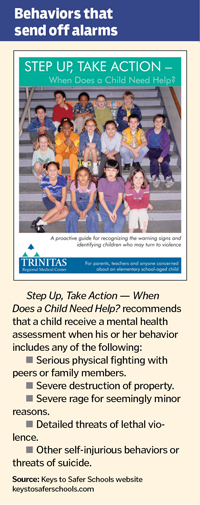By BETSY TAYLOR
When does a child need help? It's a question that receives national focus when a young person turns to mass violence, but also one that families and educators consider much more routinely when a child experiences a trauma, struggles in relationships or experiences strong mood changes.
 Trinitas Regional Medical Center in Elizabeth, N.J., has created a 20-page guide, available online and as a free booklet, to help adults grappling with these questions understand when children are in potential danger. It includes warning signs parents and teachers should look for, advice on what they should do if they think something is wrong, and who they can turn to for help.
Trinitas Regional Medical Center in Elizabeth, N.J., has created a 20-page guide, available online and as a free booklet, to help adults grappling with these questions understand when children are in potential danger. It includes warning signs parents and teachers should look for, advice on what they should do if they think something is wrong, and who they can turn to for help.
Jim Lape, the medical center's senior vice president of behavioral health, psychiatry and long-term care, explained the Sandy Hook Elementary School shootings in
Newtown, Conn., in December were the impetus for the "Step Up, Take Action" guide. Adam Lanza killed his mother at their home, then fatally shot 20 children and six school staff members at the school before committing suicide. It was the second deadliest mass shooting by a single person in American history, after the Virginia Tech killings in 2007.
"Sandy Hook, the tragedy, stimulated the need in my mind to do something to assist and better educate parents, pediatricians and teachers," Lape said. He writes in the guide's introduction, "Many 'shooters,' who are described after the tragedies they cause, are isolated individuals who have had emotional problems for years. But, they never received the attention and help they needed early enough to prevent them from putting themselves or others in danger." The prevalence of mental illness among children, and their need for mental health services is higher than many people realize, with one in 10 children diagnosed with a mental health disorder.
While every child and situation is different, the intent of the guide is to help adults better understand when to take action. For instance, the guide outlines that threats should be taken seriously if a child threatens to hurt or kill himself or herself, someone else or an animal; threatens to run away from home; or to damage or destroy property belonging to the child or someone else. It advises that such threats shouldn't be excused as "just talk" or "just a phase" and shouldn't be ignored. The adult should try to talk with the child and, if the child refuses, is not cooperative and/or continues to voice dangerous thoughts and plans, the adult should arrange for a mental health professional to do an evaluation.
The guide incorporates input from 10 to 15 psychiatrists, psychologists, social workers and the head of a parenting organization, Lape said. It takes up several situations when a grown-up may need to step in to assist a child directly or link the child to professional counseling. It includes information on depression and suicidal ideation in young children, signs a child is being bullied and what to do about it and steps to assist a child who has experienced a trauma.
Michelle Perna, a clinical social worker who serves as program director of the child and adolescent inpatient psychiatric unit for Trinitas Regional Medical Center, gave some feedback on the guide while it was being developed. She thinks it will be a helpful tool for adults. "The important thing here is that it's in a user-friendly packet with the warning signs and risk factors for children," she said.
The guide, available in both English and Spanish, was published in June and is being distributed to schools and through a regional traumatic loss coalition, a group that works to prevent suicide and to provide counselors in schools following a death or crisis. It is available in Trinitas' outpatient reception areas. Lape said it cost Trinitas between $5,000 and $6,000 to develop and print the guide.
Trinitas provides behavioral health services in many ways. It works with several schools and community organizations in the region; it has a mobile crisis service that can be dispatched in Union County, N.J., to conduct assessments, provide in-home crisis counseling, crisis stabilization or referrals. For children in need of inpatient behavioral health treatment, Trinitas has 13 acute beds and 27 intermediate beds. Children make up about a third of its 250,000 behavioral health outpatient visits annually, Lape said.
"A lot of our system is crisis-oriented," he said. The hope is that the new guide will result in greater awareness, leading to early intervention for more children, which will prevent crisis situations down the road.
> Download the Trinitas guide.